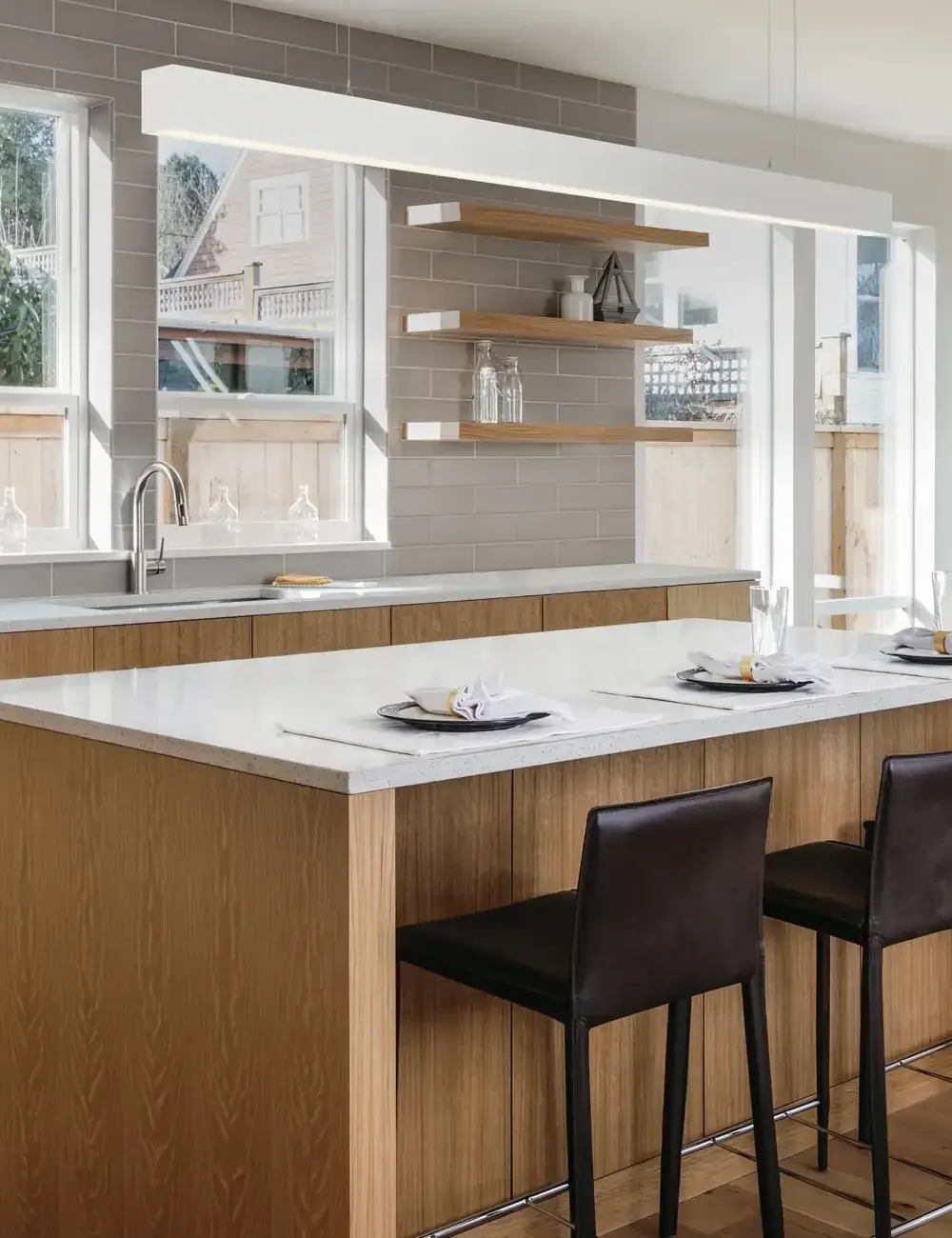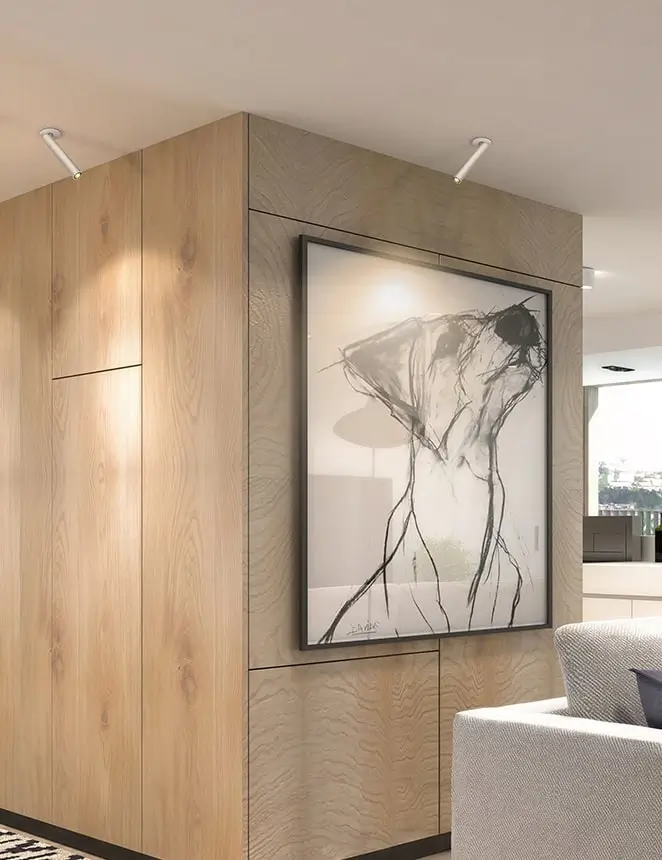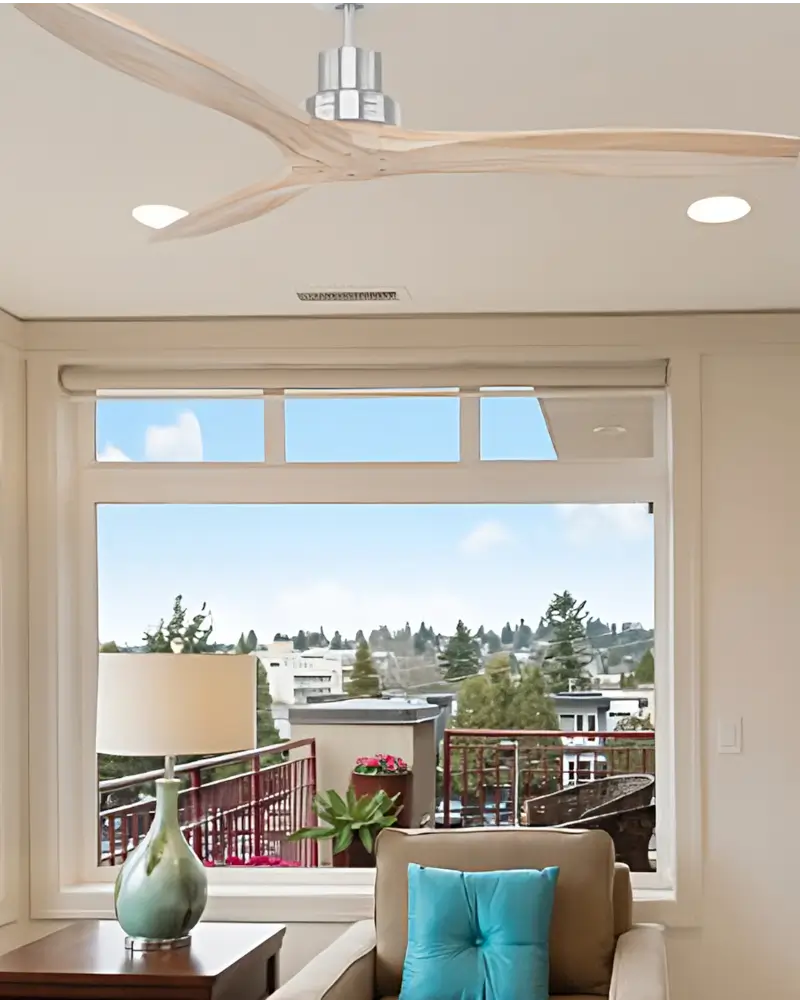To optimize the perception of space in rooms with lower ceilings, lighting plays a crucial role. By combining lighting techniques, colours, and materials strategically, you can create a visually expansive and harmonious environment. Consider the following design considerations:
Illuminate Brightly with Lighter Colours
Generally the advice for interior design with low ceilings is to select lighter paint colours for walls and ceilings. Similarly for lighting you should illuminate brightly with cooler colours, using 3000k or 4000k colour temperatures and layering your lighting will give you a bright light effect.
Embrace Ambient and Natural Lighting
Well-planned ambient lighting is vital for creating an inviting atmosphere while maximizing space perception. Incorporate recessed lighting, such as LED downlights, to evenly distribute light throughout the room. Consider installing dimmers to adjust the lighting intensity and create different moods for various activities.
Highlight Architectural Features
Draw attention to architectural elements like beams, columns, or textured surfaces by employing accent lighting. Directional spotlights or wall-mounted fixtures can emphasize these features, adding depth and character to the space. By creating focal points, you divert attention from the ceiling height and enhance the overall aesthetic appeal.
Layer Lighting for Depth
Implementing a layered lighting approach helps create depth and dimension within the room. Combine ambient, task, and accent lighting to achieve a well-balanced and functional lighting scheme. Task lighting, such as under-cabinet lights in the kitchen or bedside reading lamps, serves a specific purpose while adding visual interest.
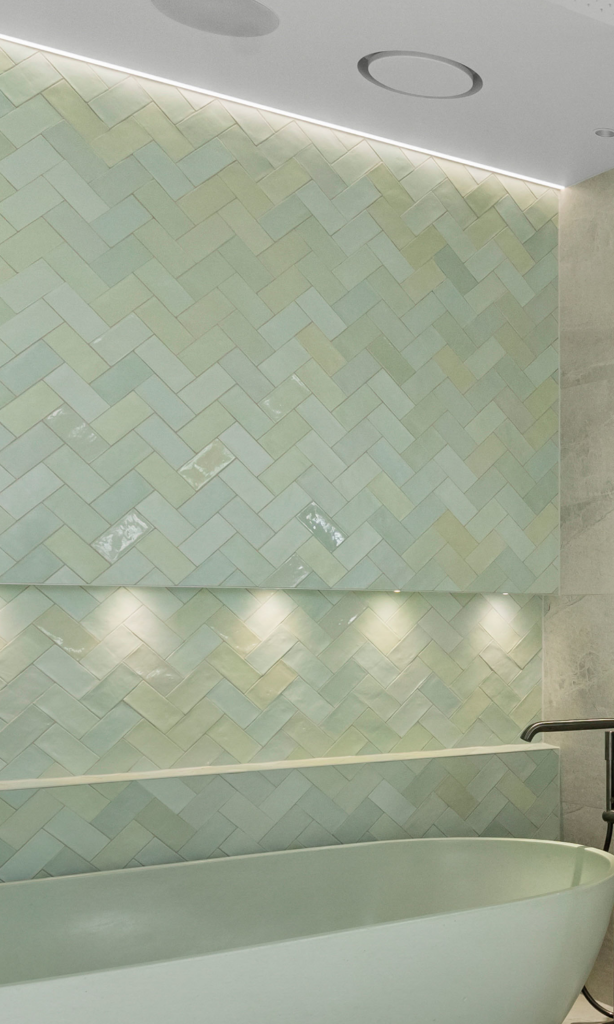
By focusing on lighting techniques that enhance the perception of space, you can transform rooms with lower ceilings into visually expansive and inviting environments. Remember to experiment with different lighting angles, intensities, and colour temperatures to achieve the desired effect.
Lighting Fixtures
To optimize both space and lighting in rooms with lower ceilings, it’s crucial to explore suitable ceiling lighting fixtures that cater to specific needs. Let’s examine the different options and their impact on the space:
Wide Beam or Medium Beam Downlights
When considering recessed lighting, such as LED downlights, you have the choice between wide beam and medium beam options. Wide beam downlights spread light across a broader area, creating a more evenly illuminated space. This can help make the room feel brighter and larger. On the other hand, lower glare medium beam downlights focus the light more directly, reducing glare and providing a more comfortable visual experience. These fixtures are particularly beneficial in areas where you want to minimize direct glare, such as open plan living spaces.
It’s worth noting that surface-mounted downlights offer a refreshing alternative to recessed lighting. While recessed downlights are popular for their sleek and unobtrusive appearance, surface-mounted downlights provide a break from the abundance of recessed lights while maintaining a modern and contemporary look. These fixtures can be mounted directly onto the ceiling surface, making them easier to install and offering flexibility in terms of placement. Surface-mounted downlights can be strategically positioned to create focused lighting or highlight specific areas, adding depth and dimension to the space.
While recessed downlights to a great job of lighting down, and from lower ceilings the cave-like feeling this can create is even more prevalent. If you use downlights for your main room lighting make sure you layer your lighting and include some more ambient lighting (wall lights, pendants or table and floor lamps) too fill in the darkened wall and ceiling areas with light.
Semi-Flush Fixtures
Semi-flush pendant fixtures are designed specifically for low ceilings. These decorative fixtures have shorter dropsets, ensuring they fit well within the space without compromising style. Strategically place these above key elements such as dining tables or kitchen islands to create a focal point and add visual interest while not feeling impeding on the flow of your home.
Ceiling Buttons
Ceiling buttons are luminaires designed to sit directly against the ceiling surface, providing a sleek and seamless appearance. They can serve as both functional and decorative elements in your lighting design. Simple and understated designs are well-suited for service areas like laundries and bathrooms, while decorative styles can enhance the aesthetics of living spaces. Flush mount ceiling buttons are particularly useful when recessed lighting is not feasible or desired. With a wide range of sizes, shapes, and finishes available, you can easily find flush mount ceiling buttons that align with your specific design preferences and lighting needs.
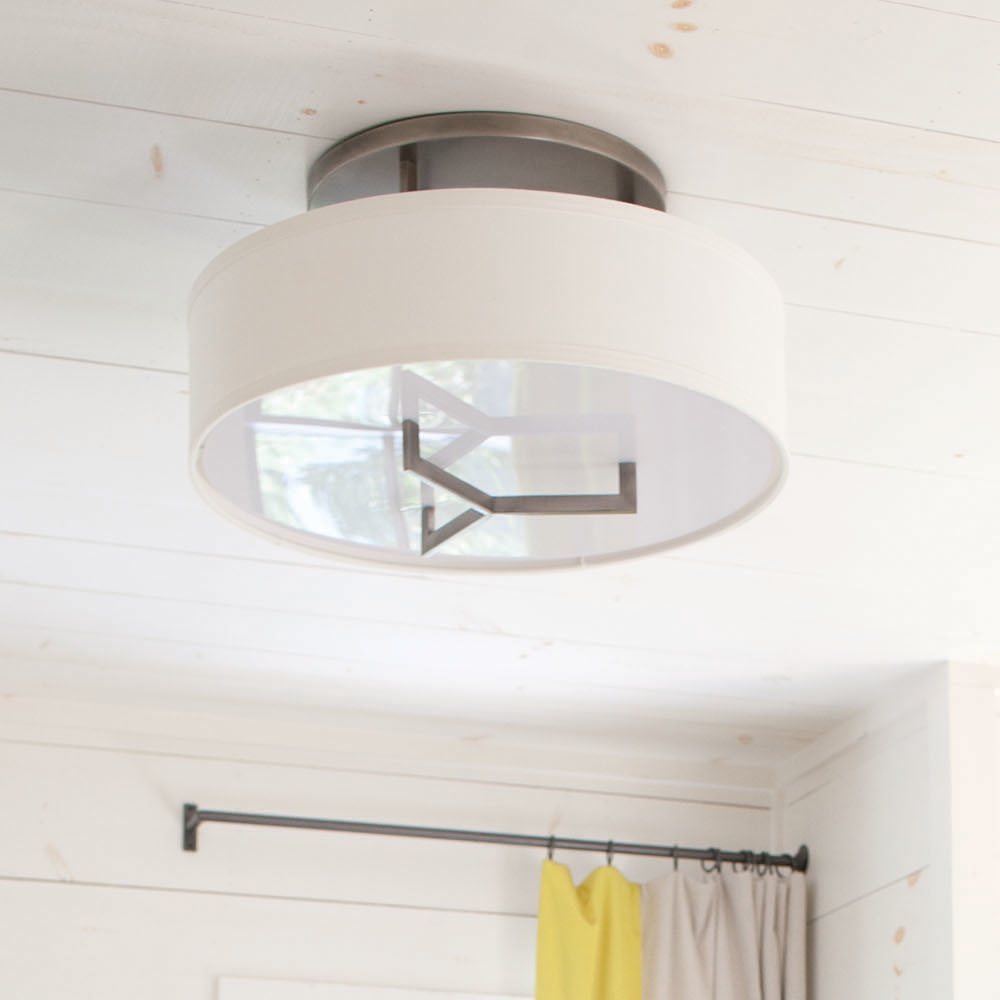
While ceiling buttons offer broad lighting coverage for the space, it’s important to consider task lights or accent lights to achieve a balanced lighting scheme. In bedroom spaces, we offer ceiling buttons that also wash light into the ceiling. When paired with a dimmer, these lights are ideal for creating a warm and relaxing atmosphere.
Track Lighting Systems
Track lighting offers flexibility and versatility in directing light precisely where it’s needed. For lower ceilings, explore recessed or surface-mounted track systems. Recessed track lighting seamlessly blends with the ceiling, creating a clean and unobtrusive look. Surface-mounted track systems add a touch of modernity and can be adjusted to illuminate specific areas or highlight artwork. These track lighting options provide an opportunity to enhance the functionality and style of the space while keeping the ceiling height in mind.
For added style check out or low voltage track systems, with a clean plastered in look these are a real talking point.
LED Strips for Recessed Ceiling and Wall Lighting
LED strips can also be incorporated into your ceilings and walls for a seamless lighting solution. LED strips are wide-angle lights that provide uniform illumination, effectively lighting up a space. By recessing these strips, you can achieve a clean and integrated look. This option is ideal for creating ambient lighting or highlighting architectural features.
Wall Lights
Low glare wall lights that can wash light into the ceiling and wall are crucial for providing ambient lighting and creating a sense of depth in the room. These fixtures help to minimize direct glare and distribute light evenly, enhancing the overall ambiance and visual appeal of the space. Wall lights with diffusers or frosted glass shades are also effective in reducing glare and producing a soft, diffused light that gently illuminates the surroundings. By washing light onto the ceiling and wall, these fixtures create a warm and inviting atmosphere, making the room feel more spacious and visually interesting.
When selecting lighting fixtures for lower ceilings, it’s essential to consider both the functionality and aesthetics of the space. Choose wide beam or lower glare medium beam downlights based on your preference for light distribution. Opt for semi-flush pendant fixtures that fit within the lower ceiling clearance. Explore track lighting systems, whether recessed or surface-mounted, for targeted illumination. LED strips recessed into the ceilings and walls offer a seamless and wide-angle lighting option for comprehensive illumination. Low Glare Wall lights can bring ambiance and mood to a space. By carefully choosing the right fixtures, you can optimize both the lighting and visual impact in rooms with lower ceilings.
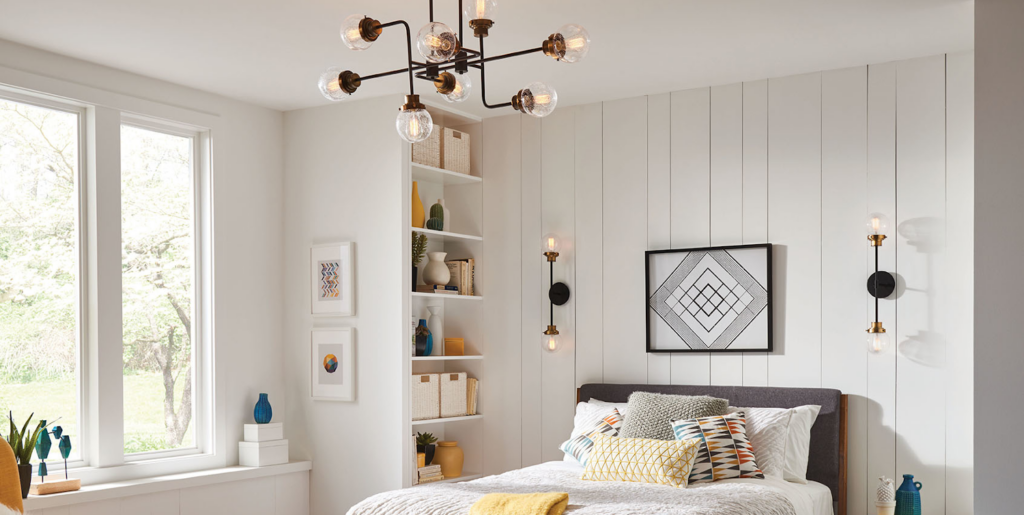
Room-by-Room Suggestions
Each room in your home requires thoughtful consideration when it comes to lighting. Let’s explore some practical advice and lighting recommendations for key areas
Living rooms
Create a warm and inviting atmosphere by combining ambient lighting, such as dimmable recessed light, recessed LED strips or ceiling lights with task lighting options like floor or table lamps. Use accent lighting such as mini downlights or spotlights to highlight artwork or architectural features.
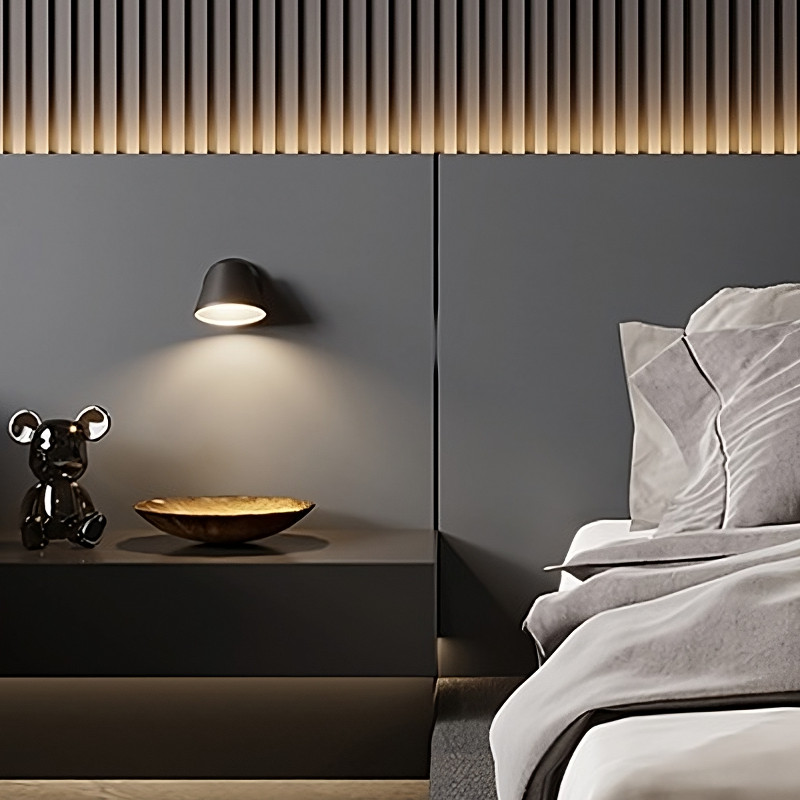
Bedrooms
Opt for adjustable wall-mounted or pendant lights on either side of the bed for convenient reading. A semi-flush fitting over the bed gives some decorative interest to the room and wide beam style downlights can be used for a clean simple layout. Install dimmers to control the lighting intensity and create a relaxing ambiance.
Kitchens
Install under-cabinet lighting to illuminate countertops and workspace areas effectively. Recessed or track lighting can provide general illumination, while pendant lights above the kitchen island add a stylish focal point.
Bathrooms
Utilize recessed LED lighting for general illumination, especially in shower areas. Add vanity lights on either side of the mirror to eliminate shadows and provide optimal lighting for grooming tasks. Where space is an issue tilting lights aimed at the mirror can provide vanity lighting.
Remember, the key is to strike a balance between functionality and aesthetics while taking into account the limitations of lower ceiling heights. By selecting appropriate lighting fixtures and considering the specific requirements of each room, you can create a well-lit, visually appealing space that feels open and welcoming. You can also take a read of our article on Light Layering for more tips on making the best use of lighting design, or get in touch if you want us to help with a professional lighting plan for your home.
